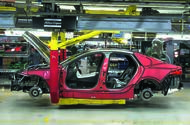Analysis: the challenges facing Jaguar Land Rover
 After several years of impressive growth, a recent sales downturn shows the hurdles facing JLR
After several years of impressive growth, a recent sales downturn shows the hurdles facing JLR
The decision last month to lay off 1000 contract staff out of a total 40,000 workforce may be a disaster for those affected but, on the face of it, it does not signal serious structural issues for Jaguar Land Rover’s business.
That said, although JLR has expanded at pace since its near-death experience after the credit crunch a decade ago, it is now facing a downturn in its fortunes.
In the year to September 2012, JLR sold 269,000 cars worldwide. In the year to March 2018, it sold 614,300. That’s impressive growth and backed by an expanded model line-up including strong sellers such as the Range Rover Velar and the F-Pace, Jaguar’s first SUV.

The top-line results for the fiscal year to March 2018 don’t look too bad, and in fact represent growth of 1.7%. However, the problem for the company lies in a marked fall-off in sales over the past six months of some of its most profitable volume models. It’s a fall-off that is most noticeable since the beginning of the year and showed no sign of slowing during March. Overall, JLR sales fell 3.8% year-on-year between January and March. But in March alone, sales were down 7.8%.
The company’s biggest issue is the UK market, where sales were down 21% in the first three months of the year and a worrying 26% in March alone. Sales in Europe were down nearly 12% between January and March. Across the rest of the world, however, company sales continue to grow. China, JLR’s second-biggest market so far this year, was up 11%.
Officially, the company blames its UK woes on consumer uncertainty over the future of diesel and the effect of Brexit.

According to figures from research company JATO, in the first quarter of 2018 the share of UK diesel sales fell to just 33%, down from a peak of 49% in 2014. With diesels accounting for 94% of Land Rover’s sales last year, that is certainly going to hit the brand hard. That said, Jaguar and Land Rover both offer petrol engines, so there should be little to stop JLR following the trend away from diesels.
But it also seems likely that JLR will face some very strong new competition, especially given the lack of hybrid drivetrains in its smaller cars.
One sales snapshot from JATO showed that, across 27 European markets in February, Alfa Romeo sold 2204 Stelvio SUVs against 1346 of the Jaguar F-Pace. Alfa sold a modest 41,000 Giulias globally in 2017 but it seems likely that this is having an effect on Jaguar XE and XF sales, chasing the same kind of keen driver who wants a rear-driven car that isn’t German.

If a revived Alfa is nibbling away at Jaguar, it also seems highly likely that Volvo’s new-generation products are proving a headache for Land Rover. Although the Range Rover Evoque has been a runaway success since it was launched in 2011, it is now relatively old and Volvo’s XC40, which is in its first year of sales, is providing hot competition.
Early in April, Volvo UK boasted that the XC40 was its most successful new-car launch yet and that the compact SUV was selling 2000 units a month in the UK alone. Likewise the Volvo XC60 is selling prolifically in Europe, outpacing the rival Land Rover Discovery Sport. In February, the XC60 accounted for 5285 sales across Europe alone, nearly outselling the Audi Q5.

As far as hybrid drivetrains are concerned, JLR is behind the pack, perhaps because the past few years were consumed by getting its home-grown petrol and diesel Ingenium engine family into production. But the next 18 months will prove crucial. Plans for a hybrid-petrol drivetrain based on a three-cylinder Ingenium engine were revealed at a briefing in September 2015. This set-up uses a compact electric motor sandwiched between the narrow engine and the transmission.
The unit is likely to make its debut in the nose of the second-generation Evoque, and then find its way into a facelifted Discovery Sport in 2019. Jaguar is also running 1.5-litre-engine XE prototypes, but it’s not known whether this is a standard turbo unit designed to offer a low-CO2 petrol alternative to diesel or another hybrid derivative.
JLR has challenges ahead, with significantly stronger SUV competition the most serious. Sales of the Range Rover Sport and Range Rover should improve after this recent model change. Slow sales of the Discovery 5 in Europe (just 691 units in February) remain tricky and much rides on a strong reception for the new Evoque and the new petrol performance and ‘eco’ versions of the XE and XF. The E-Pace is also likely to sell briskly and the I-Pace EV should significantly boost Jaguar’s brand presence. But after a decade of good news, JLR will find expansion to building one million cars a year a fair deal tougher.
Read more
Comments
Post a Comment